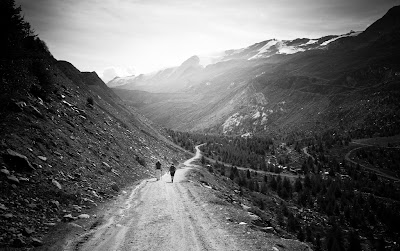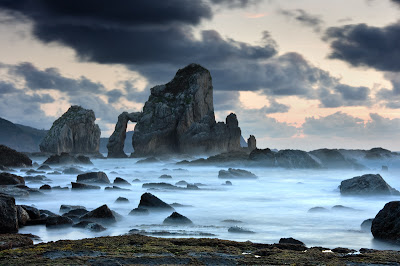There are several factors that work in tandem to make outdoor work especially landscape photography interesting. Though all photographers work to make their pictures most striking only the ones who understand the principles of outdoor photography succeed. An amazing picture is that which successfully conveys the intended message to the viewer. It is where sound knowledge to take care of the most relevant elements comes in to play. Here we will discuss three of the major components that distinguish a great photograph from the rest. An interesting photograph should be able to effectively convey:
 |
| Photo By David Kingham |
1. A sense of Scale
2. A sense of Place and
3. A sense of Magic
Conveying a Sense of Scale;
 |
| Photo By Joshua Paul Shefman |
As photographers; all of us would have had chances to be in situations quite overwhelming by the scale of the things around us. They might be either cliffs, mountains, thundering waterfalls or even manmade structures. We clicked with awe and hoped to capture the entire grandeur of the scene around us in to our frames. But when we finally go review the photographs, it would be an understatement to say that we were disappointed; ‘shattered dreams’ would be more appropriate!
Thus we discovered - the hard to digest- fact; that translating an immense physical location into 4 * 6 or 8 * 10 prints is not an easy task. Analyzing the picture we will find that the picture failed because it could not convey the sense of scale to the viewer. In this case; we need not be losers anymore. A sense of scale could easily be conveyed by adding an element; the size of which the viewers could easily comprehend. For example we want to picture a big elephant; nearby it add the picture of its mahout (the man who takes care of the animal); without that man in the frame; our ‘big’ elephant would be just an ‘ordinary’ one!
A snippet; Guruvayur Kesavan was a legendary elephant attached to Guruvayur Temple in the state of Kerala. It was famous for its extraordinary size and grandeur; at the time of its death several write-ups and photos appeared in the media; in picturing him several photographers erred on conveying the ‘sense of scale factor’; and their viewers were left just to assume that the elephant was a big one! Photographs failed to convey their message.
Finding Your Subject
Look around for interesting subjects; it could be anyone or anything that has to do something with the environment. A person, bird, animal or even structures like a barn, a building or a vehicle that helps to provide a tangible point of reference for the landscape can be a good subject.
When a subject is included in the frame our eyes automatically gravitate towards it and everything else fades back a little. Adding a subject to your photographs of Big Places not only adds a sense of scale, but it heightens viewer’s interest in the photo.
 |
| Photo By Tobi |
Photographs are most successful when subject; they have included interacts with the environment. It is with this interaction -between the subject and the environment-; the overall photo becomes the message and engages the viewer by telling a story.
Speaking about finding subjects, one of the best subjects you could ever find is a person; picturing a poverty stricken place in Africa or a war ravaged place in Afghanistan; is not complete without the affected human being and the situation in which he/she is in.
Subject; not too close.
Placing the person too close to the camera will only make matters worse, as distortion causes the person to appear larger than life or somewhat cartoon like; while everything else in the frame appearing like miniature scale models.
Organize your frame so that the subject/person gets some distance from the camera; making the size of the other elements comparable with the size of the person. Moving so close you make yourself a part of it. You and your eye should work for the viewer. In other words you should get more identified with the viewer in catching their eyeballs; not to become a part of the problem!
Subject standing out; background uncluttered;
 |
| Photo By Martin Gommel |
When a subject is placed in a cluttered background; it will go unnoticed by the viewer. Along with the subject your message will go down the drain. Place him/her against a clean background; it could be anything a solid bar of color or the blue sky or a barren land; this will make your photograph a striking one. It makes the subject stand out of the background and uses scale as another dimension of the photo.
Conveying a Sense of Place in Outdoor Photography
 |
| Photo By Eric Leslie |
Conveying a sense of place is important as it shows the viewer where you really are. It is always a good idea to start your job with a wide angle shot so that your story gets anchored within the environment.
A wide angle shot can be used to introduce the viewer to what the subject’s world looks like.
Remember, it also gives clues to the character of the subject as it is heavily influenced or affected by where he/she lives. The initial wide shot works on multiple levels, establishing the scene, introducing the subject and gives subtle hints on the character of the subject.
An outdoor photographer should give hint of the spot where he/she is; but for this trying to include all the objects make the picture rather cluttered. When there are too many elements that compete for the viewer’s attention; the viewer gets distracted from the real theme which the photographer intended to convey.
The trick to avoid it is; to focus your mind and think of the most important element that caught your eye, you’d want to convey to your viewer what’s the magic that attracted you to that locale. So isolate the element that made you pick-up the camera in the first instance; make it the main subject of your photograph. Frame it in such a way so that other elements in the frame will only complement the subject and not compete with it; your picture will convey the essence of the environment; the viewer will catch it at the first glance.
Conveying a Sense of Magic in Outdoor Photography
Capturing the play of light on the subject and the environment; its interaction with the scene creates a visual magic; in fact this magic is the soul of outdoor photography.
 |
| Photo By Justin Balog |
A girl sipping her cup of tea while the Grand Canyon lay stretched to infinity; she just sits on a rock on one ridge; it is morning; rising sun has painted a good part of the horizon in gold; one huge ridge in front casts its shade on the girl leaving her forehead; the gold paints the front and back of her hair. Whole atmosphere is cool and she waits for her hot coffee to cool down; while casts a look at the surroundings; anybody would wish to be in her place; any photographer would wish to have an opportunity for such a shot!
 |
| Photo By Kerry Sanders |
Successful outdoor photographers have this uncanny ability to be at the right place at the right time consistently. “God must have given them some sort of sixth sense!” you might envy him. That man’s ‘sixth sense’ is nothing but his dedication to the work; thorough subject knowledge, perseverance, technique and occasional luck.
There are various elements that an outdoor photographer should pay attention to, the time of the day and time of year, season, and weather conditions. Landscapes would look different at different times of the day also across seasons. The sun’s position also keeps changing during the day depending on the time of the year; all these variables create very different settings of the same scene for a creative outdoor photographer to capture.
The golden hour:– hour just before and immediately after sunset are the favorite time of shoot for outdoor photographers; during that time sun rays will have a golden (yellow) tint to them; and it also strikes the earth’s surface at an angle producing long shadows.
There are various online sources that tell you the position of the sun in any corner of the earth at any given time. So you could have a fair idea of how your location or natural feature will be lit.
An understanding of the various tools employed by outdoor photographers to negate some of the challenges of outdoor photography like using polarizing filters to control reflections, glare, increase saturation and using graduated neutral density filter to overcome limitations of dynamic range etc. would also go a long way in making the most out of any situation.
Bonus Tip: Create Interest – Make them want more!
Here are a few tips to make your photos command the attention of the viewers and make them want more.
Keep Things Simple
Make your compositions simple and elegant, remember photography is an art of exclusion, only include those that actually contribute towards the intent of the story that you wish to tell.
Capture your subject interacting with its surroundings;
Make sure that in your pictures the main subject is interacting with the environment and is not simply staring into the camera. Often a simple gesture creates a spark of interest in what could have been a boring photo.
Create Interest by Using Contrasting Colors
Contrasting colors can be used to create interest in your photographs.
Shoot During Golden Hours
 |
| Photo By Eleder Jimenez Hermoso |
The hour right before sunrise or right after sunset is called the golden hour and is considered the best time for outdoor photography.
Click at the Right Moment
There are things that our naked eyes cannot see; or even if we have seen could not deciphered its details. Through a lens we see as well as make the viewer see; even common things becoming wonderful subjects; that they would have never seen in their entire life time.
One doesn't know when a really amazing scene appears; you can freeze such a magical moment for ever. Magic doesn't just happen; we have to make it! Opportunity doesn't come and knock at our door; you have to go in search of it; knock several doors; in one magical moment; the door may be opened by the thing which we were in search of; click; click; click!
Post a Comment